 Intel has just crossed the line to unacceptable and unethical. SemiAccurate realizes these are pretty harsh accusations but if you look at the evidence below, there is no question about the company’s methods or intent.
Intel has just crossed the line to unacceptable and unethical. SemiAccurate realizes these are pretty harsh accusations but if you look at the evidence below, there is no question about the company’s methods or intent.
The author has been covering Intel for about a decade and a half as a journalist and followed them closely as an enthusiast and technology worker for far longer than that. During this time Intel has seen highs and lows, good products and bad, but one thing was always consistent, honesty. Even during the low periods like the P4 vs K8 battle when Intel was being pummeled, they always took the high road on messaging.
This took the form of sending out chips they knew would lose to the competition coupled with an explanation of where they expected the device to do well in the market. Some of those expectation strained credulity at times, but to the best of our recollection, were never directly inaccurate. There were times when you scratched your head or even mocked the framing, but you never walked away with the impression they were being dishonest. Intel was the gold standard for messaging.
Similarly there were briefings where slides and data were presented that could not be published. These were always called out ahead of time and the explanations for why were given. Examples of this were far pre-release devices that had outstanding bugs, known firmware updates coming that would radically change performance, or simply incomplete benchmark runs. This last one was especially prevalent in enterprise and server briefings when some of the tests require huge configurations, official certifications, or simply could not have data released until the product was farther along because of benchmarking organization rules. See the Spec disclosure rules for more on this.
In all of these situations, Intel made it clear what the numbers represented, what they did not represent, and why we could not get a copy of them. It is hard to think of a time when the way it was done was not the proverbial ‘right way’. We can not think of a time when this was done with an intent to mislead or confuse. There were occasional times when Intel did not allow pictures and did not give out slides, but those were exceedingly rare, and one was even justifiable. Again Intel always tried, or at least seemed to try to do the right thing for the right reasons.
Sadly that is no more. Today Intel crossed the line from the gold standard of accountability and ethics to unacceptably unethical and purposefully misleading messaging. While SemiAccurate does not know who made these decisions, based on more than a decade of working with Intel, we strongly suspect the changes came from far above the front lines of PR. We don’t take this as comforting news.
So what happened? On March 15th, Intel gave a press briefing in the form of a webcast on Xpoint SSDs. There were two products talked about, the P4800X enterprise SSD and the M.2 Xpoint based consumer Optane Memory. The P4800X had an embargo lift a week or so ago, the M.2 SSD was publicly revealed today.
Both suffered from what SemiAccurate feels is unethical messaging, and both seemingly did so to obfuscate the fact that the products were not very good. Instead of taking the high road, Intel tried to get the press to say things they couldn’t say directly by means of purposefully unethical messaging.
What did Intel do? They put out a briefing with lots of slides, data points, and fine print in the briefing. These gave the impression that the products were far better and more impressive than they were. When the slides were released, several key ones on the P4800X were absent, including almost every one that had real world non-synthetic test results. Worse yet on the M.2 SSD slides, over half were missing including every single one that contained testing data, configurations, and information necessary to back up the claims made in the webcast. This is unacceptable behavior in the best of circumstances.
Normally when this happens, SemiAccurate asks about the missing slides and gets a response that is along the lines of, “Sorry we sent out the wrong deck by accident, here is the real one”. This happens more often than you think but most of the time it really is a SNAFU, especially when late changes are made after the decks are already sent to an agency. More often than not these mistakes are proactively corrected before the press even notices, but sometimes we have to ask.
This time the email with the slides came with the quote of, “The slides from the call this morning are attached .” Fair enough. We soon noticed the missing P4800X slides because one had questions we needed clarification on. During our back and forth with Intel people we asked, “Still working on the story, but where are the missing slides?”. The reply, “We did not share all the slides that were presented. Sorry.” This directly contradicts their earlier email and shows they removed the slides intentionally. A later phone call with other Intel personnel confirmed that the removal was intentional. Again, completely unacceptable with intent to mislead.
Misleading with intent is a really serious accusation, so why do we keep saying it? Lets take a look at the slides Intel doesn’t want you to see and point out why they likely were pulled. We will exclude the live demo slides/videos of Adobe, WoW and Office loading times because most presentations pull those when converting to PDFs for obvious reasons.
We will say that in the overwhelming majority of these cases, those slides do have placeholder or results summary in their place, Intel simply blackholed the two demos in this case. To give you an idea of how much was scrubbed, the slides had P4800X first then M.2, and the one published in our M.2 story was slide 28 in the public deck.
While some were re-ordered slightly, the same slide in the press briefing was slide 43. Worse yet the public deck only has 31 slides, the press briefing had at least a dozen more slides after 43. Intel may not have pulled half the slides from the entire deck but it was close. The majority of the M.2 slides were removed, the minority but still key slides were pulled from the P4800X portion. So what was pulled?
When SemiAccurate said the key performance data was pulled, we weren’t joking. The press briefing had many examples of demos and benchmarks with tons of figures how great Xpoint SSDs were. They stated how fast it sped up a PC and backed it up with numbers. The intent was for the press to believe that the product made things great. Then they pulled 100% of this data and every related slide. For example this slide.
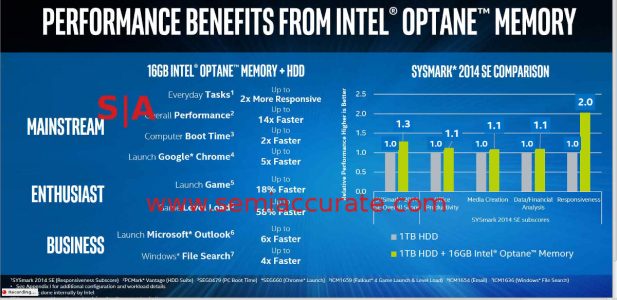
Look, real vague data to scrub
Normally this is done to give an impression and weeks later when it is written up, give the writer nothing to potentially contradict that impression. It is one of the sleaziest PR tactics out there. Why was this one pulled? If you look at the numbers, they all look solid, clear wins for the Xpoint M.2 right? Sure it was in an Intel controlled benchmark with its mailing address in an Intel building, but is that relevant? (Note: All mailing addresses have been scrubbed from Bapco’s site since the scandal broke years ago, but Intel still, “doesn’t control it”)
In and of itself this may not be sketchy but there are two things that stand out. First is that none of the benchmarks are actual performance numbers that enable public testing in a way that can be compared against in independent testing. The ‘configuration’ is intentionally vague and not listed in the fine print that was cut off. This is unethical and intentionally misleading. They also normalize the numbers so you can’t get absolute data to compare against.
The little configuration details they give, “1TB HDD” and “1TB HDD + 16GB Intel Optane Memory” are simply laughable. Worse yet they compare a presumably high-end system, the drivers for M.2 Xpoint are only available for a Kaby Lake system on a Z270 motherboard and Windows 10, and do so with a magnetic HDD. This is problematic for two reasons. First no one buys a system like that with an accelerator and puts a magnetic drive in it. If they are truly that uneducated it is so unlikely that they will understand Xpoint in order to add it that it is not worth mentioning.
The second problem is more fatal to the product, Intel never compares an Xpoint SSD to a NAND SSD. There were no numbers in the presentation against an SSD, none in the tests, and none anywhere. Why? Because Xpoint would probably lose badly against a mid-range consumer SSD which typically have many more channels. If you look at the scant bandwidth numbers released for the P4800X, it loses to the flash-based P3700 but a noticeable margin on sequential reads and tied it on writes.
This does not bode well for comparisons to M.2 form factor NAND sticks which can routinely max out their PCIe3 2x bus. Lets see what happens when independent numbers come out but SemiAccurate would be surprised if Xpoint didn’t lose. The comparison to a magnetic HDD was by choice with an intent to mislead. Pulling the slide was a way to accomplish that goal, they hoped journalists wouldn’t remember the vague specs.
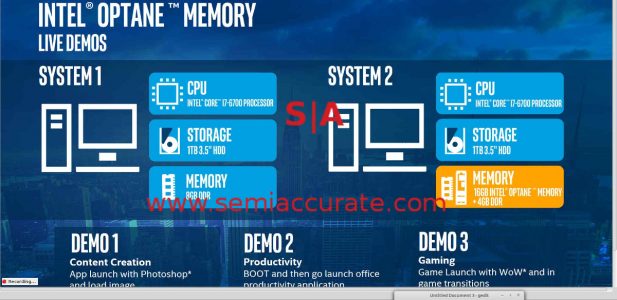
How’s this for detail?
Similarly with the above specs for the demos. Notice how vague they are? Also notice how they take a high-end i7-6700 CPU which has to be on a Z270 motherboard with Windows 10 and put 8GB of DDR at unspecified frequency on board? And coupled it with a magnetic HDD? On the Xpoint system they did the same but halved the DRAM to 4GB, a barely functional Windows 10 system at that point. Does anyone think a new i7 Kaby Lake/Z270 system with 8GB is realistic? How about one with 4GB and an accelerator that costs as much as 8GB of DDR3 for the listed configuration? Think this spec slide was pulled for a reason? And no the fine print at the bottom contained no more details, Intel did not put it in for a reason, and not a positive reason.
The following slides were demos of the specs above in the tests above. In all of these tests Intel’s 4GB DDR + 16GB Xpoint + 1TB HDD system beat the 8GB DDR + 1TB HDD rig by a margin of about 3x. Since it was a video we don’t have exact numbers and Intel pulled all traces of the demos and tests, not a single slide or figure. I will leave it to you to decide if these configurations are ‘typical’ or even sane, you probably know where we stand on the issue.
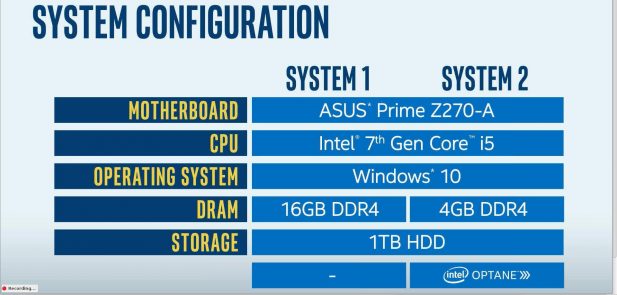
Note the disparities to the above specs
On the next slide they presented ‘more detail’ which ironically contained less detail, the CPU type is missing. One thing it does is directly contradict the earlier configuration slide which list the demo for the MS Office Launch as using an i7-6700. Again since it was pulled, will anyone notice such glaring inconsistencies when they write the story up a week or more later? To SemiAccurate this is both unethical and shows intent to deceive. And it is just sloppy.

Xpoint can save beelyunz!
After a slide listing typical scenarios for consumer and business computing use that was included in the released slides, Intel put up the one above about cost savings. This clearly shows an exact figure for how much a Xpoint SSD would save the consumer. It was pulled too. I will leave it up to you to decide if the numbers are realistic but these slides are typically pulled when they are deemed indefensible by legal because the backing data is irrelevant or lacking. We don’t know why this particular one was pulled, all we can say is that it was.
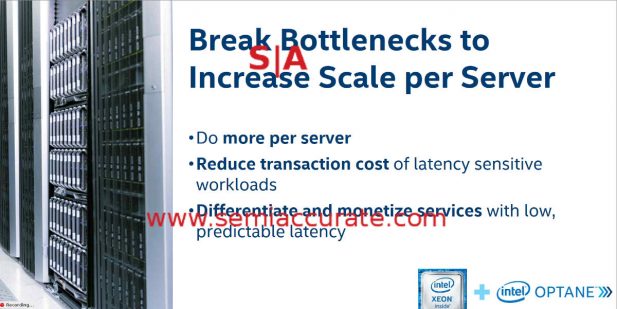
Intel direct Xpoint claims
Moving on, numerically backwards, to the P4800X slides we have the one above, also pulled. It may look innocuous but to legal it probably isn’t. Slides that state benefits without backing data are usually forbidden because it invites lawsuits. Here Intel made three distinct statements for the P4800X and didn’t back them up. Pulling it was probably right but presenting it to the press, making those claims, and then pulling the slides was probably intended to make the press write the claims ‘in their own words’. This is what we called the sleaziest of PR tactics, trying to get the press to write things you know you can’t legally say or claim. Unethical in the extreme.
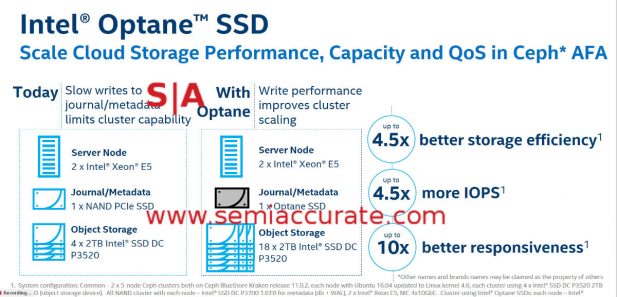
Pulled Ceph slide
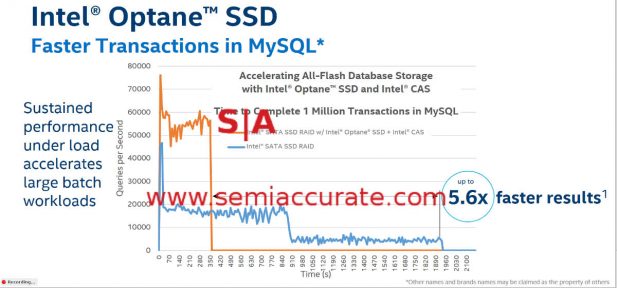
Pulled MySQL slide
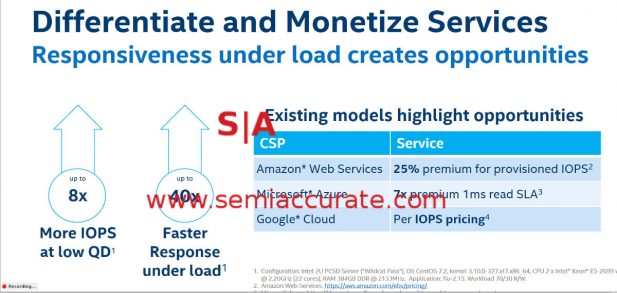
Money claims without data are a non-no so bye-bye
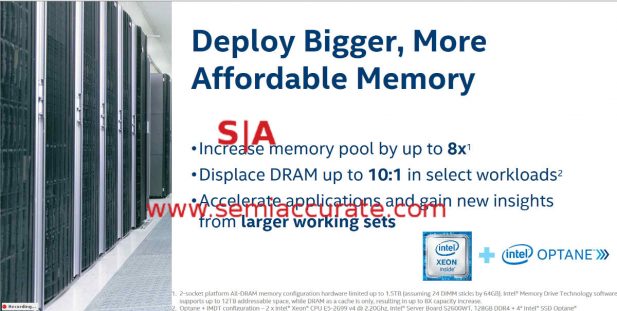
Yet another claims slide
The above four slides were part of a five slide run only one of which, a slide similar to the Ceph one, was included in the release decks. We can’t say for sure why they were pulled but the reasons are usually that the claims presented can’t be backed up or are likely to be trivially disproved. For the same reasons as mentioned prior, pulling these is a deeply disturbing and unethical move.
Last up there were several testimonials and quotes from VMware and others about Xpoint and the P4800X, These too were pulled for reasons SemiAccurate can’t begin to fathom. If a company not Intel sent in quotes, those had to go through a separate legal vetting process at their respective organizations. Intel put them in the briefing and then silently pulled them for no reason. While we don’t have a copy of these particular slides, from memory all seemed positive to Intel.
Other than slides we have one other very problematic point, data sheets. SemiAccurate asked Intel, “Can I get detailed specs on both products such as writes per day, overall endurance, performance on R/W, and the usual stuff?”, to which they replied, “I will share product briefs when I have the final versions.” So far we have received a few ‘infographic’ quality marketing PDF for the P4800X and nothing at all on the M.2 SSD. While Intel can claim the documents are not final, they have been floating on the web for months and were released to partners. Similarly there is no trace of the P4800X’s data sheets in ARK and only marketing fluff devoid of hard data on the Intel site.
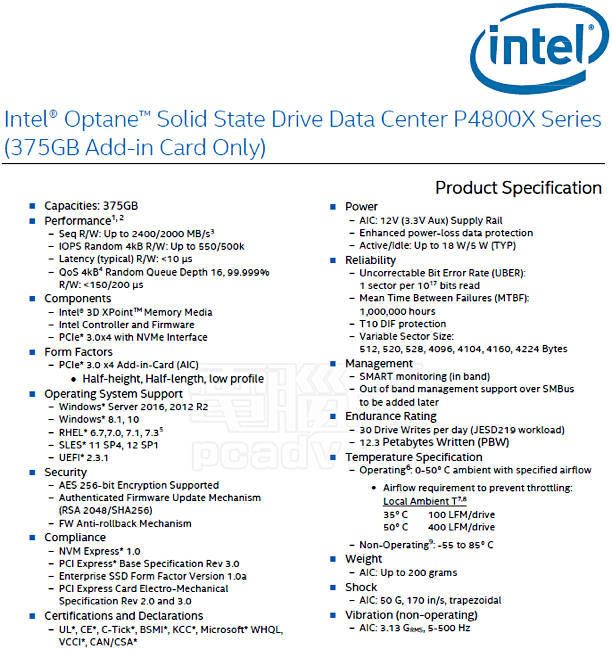
Intel can’t find this for the press
So there you have it. In a few short months Intel has gone from the gold standard in messaging to quite simply unethical and untrustworthy. What they did with the Xpoint briefing is unquestionably meant to mislead the press and have them mislead consumers in ways that they are not allowed to do. Coupled with a complete stonewalling of independent testing before launch, the reasoning is doubly clear. Intel has shattered their hard-won corporate honest built up over decades for no good reason at all. It is a sad day for the company.S|A
Charlie Demerjian
Latest posts by Charlie Demerjian (see all)
- Qualcomm Is Cheating On Their Snapdragon X Elite/Pro Benchmarks - Apr 24, 2024
- What is Qualcomm’s Purwa/X Pro SoC? - Apr 19, 2024
- Intel Announces their NXE: 5000 High NA EUV Tool - Apr 18, 2024
- AMD outs MI300 plans… sort of - Apr 11, 2024
- Qualcomm is planning a lot of Nuvia/X-Elite announcements - Mar 25, 2024